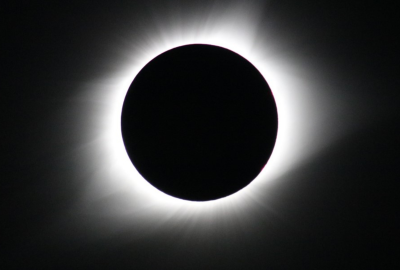The upcoming solar eclipse on April 8 is expected to be an extraordinary occurrence due to increased sun activity, a solar physicist informed Newsweek. The celestial event in April, which will traverse across a large portion of the United States, Mexico and Canada, coincides with the peak of a solar maximum when the sun is particularly active, according to forecasts from NASA and the US National Center for Atmospheric Research (NCAR). The sun’s activity fluctuates during 11-year cycles, and the peak of solar maximum is nearing this year, as revealed by Space Weather Prediction Center Bryan Brasher to Newsweek earlier. During a solar maximum, the sun releases coronal mass ejections (CME), which are significant eruptions of magnetized plasma from the sun’s outer atmosphere, known as the corona, Brasher explained. These CMEs lead to an increase in geomagnetic storms and solar flares and also produce “spectacular auroras,” he mentioned. Scott McIntosh, a solar physicist with NCAR, informed Newsweek in an interview that the solar eclipse in April will be an “amazing” event due to all of this activity.

A photograph of a total solar eclipse from February 1980 taken in India. The 1980 eclipse occurred during a solar maximum.
NCAR

A picture of the total solar eclipse in August 2017, captured in Madras, Oregon. The 2017 eclipse took place close to a solar minimum. The forthcoming total solar eclipse on April 8, 2024, will be the final one until 2044, and it is anticipated to be even more remarkable due to the increased sun activity.
NASA/Gopalswamy
What makes this solar eclipse special Although there are around two solar eclipses visible somewhere on Earth every year, totality occurs less frequently, according to NASA. A total solar eclipse happens when the moon moves between the sun and Earth and entirely obstructs the view of the sun, leading to a brief period of darkness. The April eclipse will be the last total solar eclipse visible in the U.S. until 2044, as confirmed by NASA. This year’s event is expected to appear different from recent solar eclipses due to the solar maximum. During the last total solar eclipse in 2017, the circular “orb” appeared smoother because it took place near a solar minimum, according to McIntosh. He mentioned that the appearance of the April eclipse will more closely resemble that of an “angry hedgehog.” “You can see the solar maximum eclipse corona is very spiky and the influence for my ‘angry hedgehog’ comment,” he said. “In addition to the highly structured corona at maximum, there is also a lot more dynamics driving those magnetic fields on the sun’s ‘surface’ so the potential for observing a solar flare or ‘coronal mass ejection’ is way higher at a maximum total eclipse,” McIntosh added. The pathMore than 31 million people reside in the path of totality for April’s total solar eclipse, as per NASA. The celestial event will begin over the South Pacific Ocean, and weather permitting, the initial area in continental North America to experience totality will be Mexico’s Pacific coast at approximately 11:07 a.m. PDT, stated by NASA. The trajectory is projected to then stretch from Mexico into the U.S., traversing across Texas, Oklahoma, Arkansas, Missouri, Illinois, Kentucky, Indiana, Ohio, Pennsylvania, New York, Vermont, New Hampshire, and Maine. NASA points out that small parts of Tennessee and Michigan will also witness a total solar eclipse. The eclipse will continue through parts of Canada. People in states within the path of totality can also anticipate viewing a partial eclipse before and after the period of totality. The timeframe for when the total solar eclipse will occur varies by location, but onlookers can likely observe the celestial event for over an hour, with totality lasting for several minutes.
In Dallas, Texas, a partial solar eclipse is projected to commence at 12:23 p.m. CDT and finish at 3:02 p.m., with the totality beginning around 1:40 p.m. and lasting until roughly 1:44 p.m., as outlined by NASA. For eclipse enthusiasts in Caribou, Maine, the partial eclipse is estimated to begin at 2:22 p.m. EST and end around 4:40 p.m., with the totality starting at 3:32 p.m. and lasting around two minutes. While 13 states will be within the path, NASA states that nearly all people in the U.S. will be able to witness at least a partial eclipse. “You don’t need to live within the path of totality to see the eclipse – in April, 99 percent of people who reside in the United States will be able to see the partial or total eclipse from where they live,” NASA mentions on its website. “Every contiguous U.S. state, plus parts of Alaska and Hawaii, will experience at least a partial solar eclipse.”
What to expectFor spectators within the path of totality, temperatures might drop for a few minutes, as per McIntosh’s information to Newsweek. “If you are on the path of totality you’ll experience an appreciable change in temperature, and noise as the birds and insects get fooled by the fake twilight,” he stated, noting that during the 2017 total solar eclipse in Wyoming, there was a decrease of around 10 degrees during totality. McIntosh suggested wearing eye protection “up to and after totality,” but removing the glasses during totality can provide a better view of the iconic glowing “orb” or “halo.” “During totality, you have to remove the light blockers,” McIntosh said. “Remember, the corona you’re looking at is one million times fainter than the disk of the sun you are blocking out.” “It’s a full experience, audio and visual,” he emphasized. “The reaction of the local wildlife is something else – as is that of those around you also taking in the ‘feast.’ The ghostly colors of the totality eclipse are very hard to capture and best experienced without the glasses. The shimmering light of the eclipse corona is incredible, and many become ‘addicted’ to the experience.”
Uncommon KnowledgeNewsweek is dedicated to questioning conventional knowledge and identifying connections in the pursuit of mutual understanding. Newsweek is dedicated to questioning conventional knowledge and identifying connections in the pursuit of mutual understanding.














